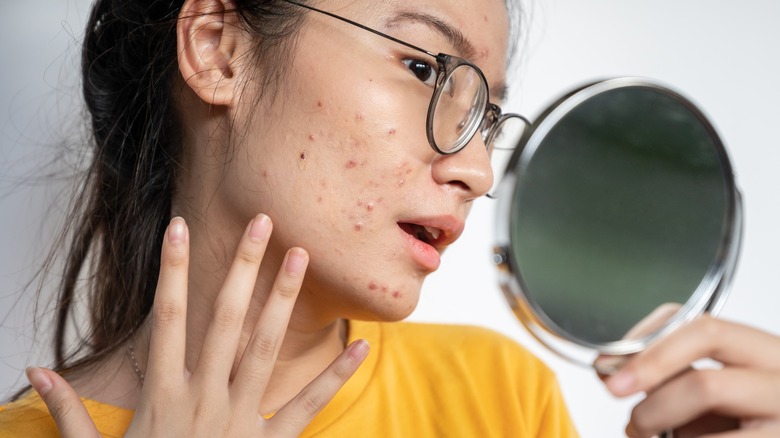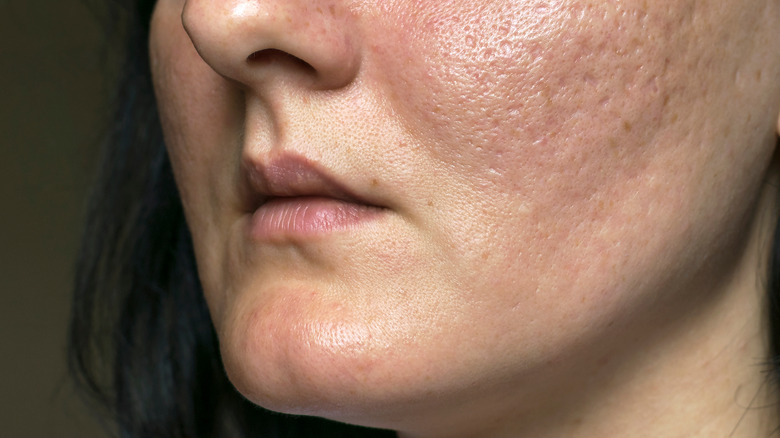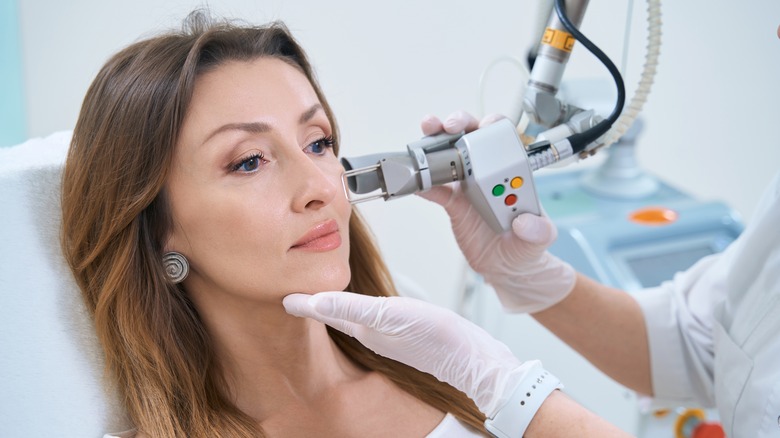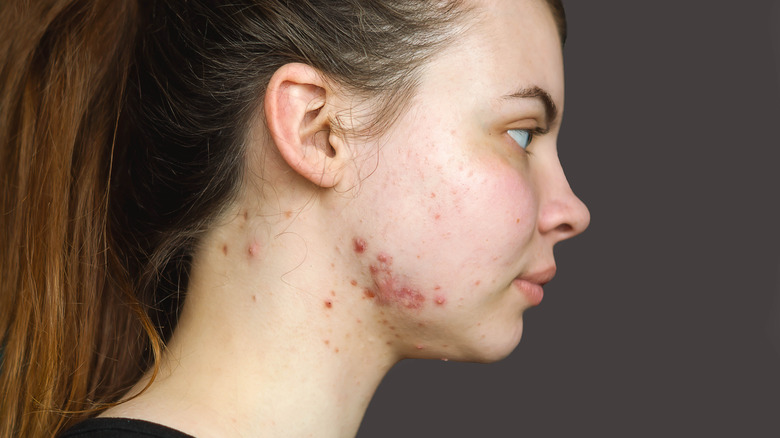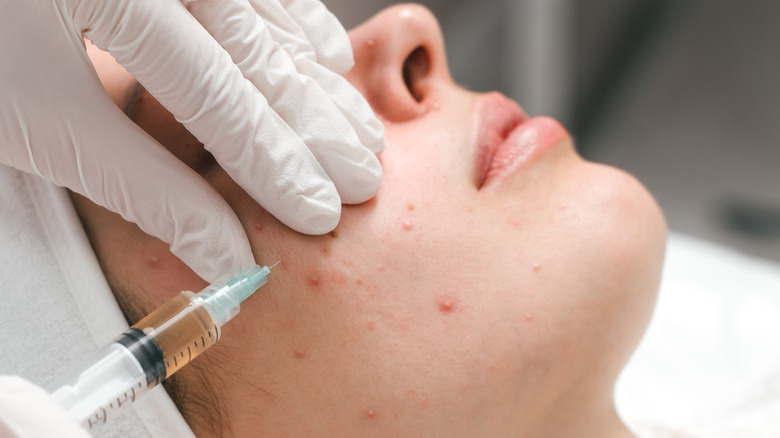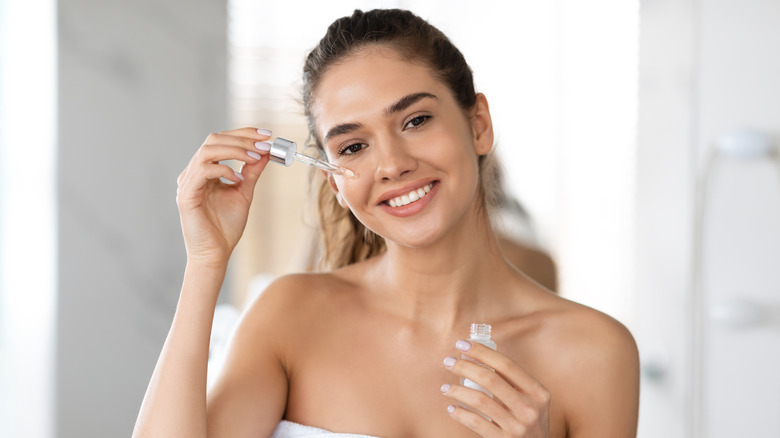What To Know About The Different Types Of Acne Scars And How You Can Treat Them
We may receive a commission on purchases made from links.
For many of us, our teenage years were spent trying not to pop painful pimples and, when we inevitably failed, resorting to unadvisable home remedies like toothpaste. Although skin positivity, the movement that embraces acne and wrinkles, is steadily picking up steam, years of social media filters have created unrealistic expectations. Holistic dermatologist Cyele Fishman recounts her experience treating adult patients with persistent acne, telling Elle, "When I ask [them], 'How does this make you feel?' the responses I get are: 'I don't signup for projects at work that will have a presentation or 'I haven't had sex in two years because I'm terrified to take off my makeup.'" Even in the face of internet criticism, creators like Constanza Concha (@cottyconcha), Sofia Grahn (@isofiagrahn), and even "Nope" star Keke Palmer are working to destigmatize unfiltered skin.
Most young adults experience acne in one form or another, be it hormonal, cystic, or — in the wake of COVID-19 — mask-related. According to Cleveland Clinic, 20% of adults have acne scars. Despite being so common, these marks aren't easy to target. When it comes to ice pick divots, keloids, and hyperpigmentation, there's no one-size-fits-all solution. If you do decide to take on your texture, here's how to identify what type of scarring you're dealing with and how to treat it best. More often than not, topical solutions won't be enough.
Atrophic scars vary and width and depth
The vast majority of acne scars are atrophic, meaning they form a slight dip in the skin. Within this larger category are three subgroups: icepick, boxcar, and rolling scars. Icepick scars are by far the most common, caused by inflamed, pus-filled cysts that form on the oiliest parts of the cheek. Despite their depth, these V-shaped atrophic scars boast the smallest circumference (via The National Library of Medicine).
Comparatively, boxcar scars are circular, wide, and tend to lean more shallow. If you're in the habit of picking at stubborn pimples or lack collagen, you're more likely to develop these U-shaped divots on your jawline. Finally, rolling — or M-shaped — scars are the widest of the three, ranging up to 5 millimeters in length, according to Medical News Today. Although some atrophic scars can fade in appearance over time, you'll likely you'll need medical treatment to jumpstart the healing process.
Indents might require minor surgery
Whereas over-the-counter topical treatments can be helpful when it comes to moderate breakouts, the scars left behind by severe acne usually require dermatologic procedures. If your atrophic scars are shallow, a doctor may try to refresh your skin with a chemical peel or multiple peel appointments. According to The National Library of Medicine, these treatments will include ingredients like salicylic acid, glycolic acid, or Trichloroacetic Acid (TCA). For severe scarring, more in-depth treatment may be necessary.
The appearance of icepick scars, in particular, can be improved with punch excision or punch grafting. In both cases, V-shaped divots are removed using a surgical hole punch tool. From here, the doctor will sew the sides of the opening back together (punch excision), or, in the case of punch grafting, use a skin graft to refill the gap, per Verywell Health.
When it comes to boxcar scars, dermabrasion and microdermabrasion are both popular skin remodeling methods. As dermabrasion is more invasive, it will require a local anesthetic. A doctor uses a surgical sanding instrument to exfoliate the surface of your face — this procedure is not recommended for those with darker skin tones, as it can lead to permanent discoloration. Microdermabrasion is the more gentle relative of dermabrasion, and will not require a numbing. Alternatively, dermal fillers, injectables made from hyaluronic acid or Bellafill, can minimize indents (via Healthline). Rolling scars — and some boxcar scars — are best treated when collagen is stimulated. This can be done with the help of laser therapy.
Keloid acne scars look like raised bumps on the skin
Whereas atrophic scars have a pitted appearance, keloid scars are raised and usually appear on the jawline, chest, and back. As the skin heals from stubborn acne, it can sometimes produce too much collagen, leading to these purple, pink, or brown bumps. Board-certified dermatologist Dr. Michele Green explains the process in a conversation with Byrdie. "As the skin repairs itself from an acne breakout, the wounds that are formed as a result of broken skin starts to heal," she says, adding, "As the skin heals, our body produces collagen which is the fibrous tissue that repairs the skin. In some instances, our bodies produce too little or too much fibrous tissue resulting in uneven texture in the skin, also referred to as a scar." According to The American Academy of Dermatology Association, those with darker skin are more likely to experience raised tissue.
Although often referred to interchangeably with hypertrophic scars, keloids can expand beyond the confines of the initial acne lesion, making them particularly difficult to treat. Comparatively, hypertrophic marks are contained and can disappear over time.
Lasers and injections are used to treat keloid scars
Before you begin the treatment process, it's important to completely recover from current breakouts. As board-certified dermatologist Dr. Jenny Liu notes on TikTok, "when I see [keloid scars], first and foremost we need to make sure acne is under control. Otherwise the scars are just going to keep popping up." When it comes to keloid scars, in particular, she recommends intralesional steroid injections, cryotherapy sessions (which involve freezing the raised tissue), botox injections, and laser treatments. Although surgical removal is also an option, this can sometimes make scarring worse, especially if you don't follow up with the proper aftercare.
For smaller hypertrophic scars, silicone gel topicals have proven effective. Not only will it provide necessary hydration, according to Dr. Andrea Suarez (aka Dr. Dray), but it will also reduce itchiness. She also recommends centella serum to heal the skin barrier and (as always) SPF.
Hyperpigmentation can be treated at home
Although hyperpigmentation can be caused by a slew of environmental factors, acne is a common culprit. Unlike atrophic and keloid scarring, these purple, brown, or red spots are flat and can be treated with over-the-counter topicals. As board-certified dermatologist Dr. Mona Gohara outlines for Allure, "Hyperpigmentation is the point in time wherein your melanocytes, your little pigment-producing factories, have decided that it's time to work overtime." In the wake of inflamed pimples, they may do this as a reactionary measure.
To treat dark spots, Dr. Daniel Sugai (aka @drspf) recommends retinoids like CeraVe's resurfacing retinol serum — under $20 on Amazon — or, on the pricier end of the spectrum at nearly $45 for 30 milliliters, La Roche-Posay's retinol B3 serum. Alternatively, use your favorite vitamin C serum twice a day, improving collagen production in the process. In some cases, hyperpigmentation will fade without the help of topicals. However, if yours is of the particularly-stubborn variety, consult your dermatologist. Professional chemical peels, laser treatments, and even microdermabrasion can go a long way. When in doubt, remember that SPF is one of the best skincare ingredients for treating stubborn acne scars.
